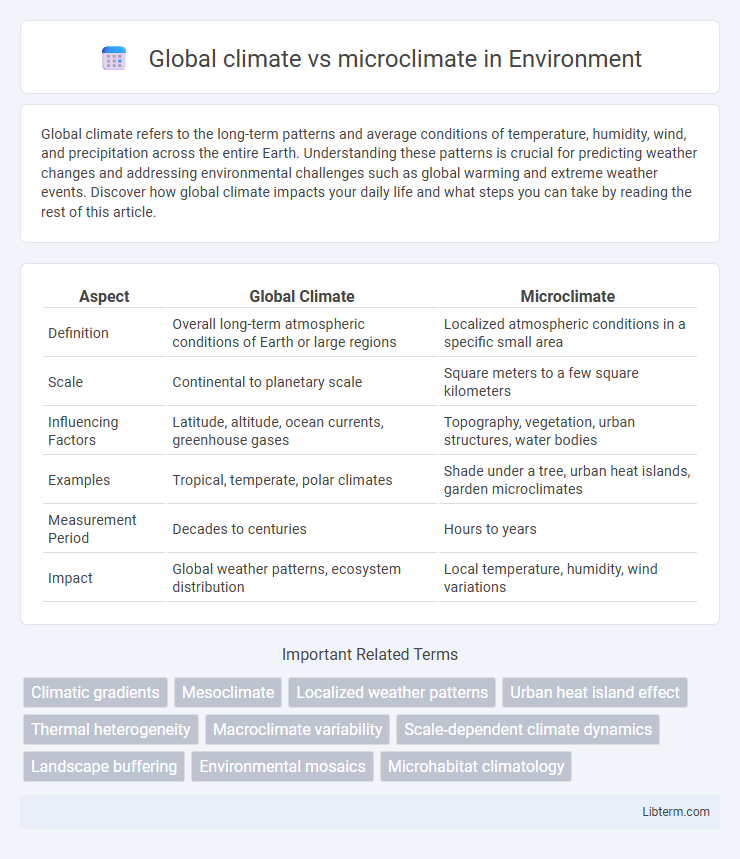Global climate refers to the long-term patterns and average conditions of temperature, humidity, wind, and precipitation across the entire Earth. Understanding these patterns is crucial for predicting weather changes and addressing environmental challenges such as global warming and extreme weather events. Discover how global climate impacts your daily life and what steps you can take by reading the rest of this article.
Table of Comparison
| Aspect | Global Climate | Microclimate |
|---|---|---|
| Definition | Overall long-term atmospheric conditions of Earth or large regions | Localized atmospheric conditions in a specific small area |
| Scale | Continental to planetary scale | Square meters to a few square kilometers |
| Influencing Factors | Latitude, altitude, ocean currents, greenhouse gases | Topography, vegetation, urban structures, water bodies |
| Examples | Tropical, temperate, polar climates | Shade under a tree, urban heat islands, garden microclimates |
| Measurement Period | Decades to centuries | Hours to years |
| Impact | Global weather patterns, ecosystem distribution | Local temperature, humidity, wind variations |
Understanding Global Climate: An Overview
Global climate encompasses long-term atmospheric conditions averaged over large geographic areas, driven by planetary factors such as solar radiation, ocean currents, and greenhouse gas concentrations. It governs broad weather patterns and climate zones, influencing ecosystems and human activities worldwide. Understanding global climate involves analyzing historical data, climate models, and global climate systems to predict changes and assess impacts on a macro scale.
What is Microclimate? Definitions and Key Features
Microclimate refers to the localized atmospheric zone where climate conditions differ from the surrounding areas, often influenced by geographical features like buildings, vegetation, and bodies of water. Key features of microclimates include variations in temperature, humidity, wind patterns, and solar radiation on scales ranging from a few square meters to several kilometers. Unlike global climate, which encompasses broad patterns and long-term trends across large regions, microclimates are highly specific and can significantly impact local ecosystems, agriculture, and urban planning.
Key Differences Between Global Climate and Microclimate
Global climate refers to long-term atmospheric patterns and temperature trends across large geographic regions or the entire planet, influencing broad ecosystems and human activities. Microclimate describes localized atmospheric conditions, often within a small area such as a garden, urban neighborhood, or valley, affected by factors like topography, vegetation, and human structures. Key differences include scale, variability, and temporal scope, with global climate representing widespread, stable patterns, while microclimate features highly variable, site-specific weather conditions.
Factors Influencing Global Climate Patterns
Global climate patterns are primarily shaped by factors such as solar radiation distribution, ocean currents, atmospheric circulation, and the Earth's axial tilt and orbit. Variations in greenhouse gas concentrations and volcanic activity further impact long-term climate trends. These large-scale influences differ from microclimates, which are affected by local terrain, vegetation, and human activities.
Local Influences: Determinants of Microclimate
Local influences such as topography, vegetation, and urban structures play a crucial role in determining microclimates by affecting temperature, humidity, and wind patterns at a small scale. Microclimates can vary significantly within short distances due to factors like elevation, water bodies, and shading from buildings or trees. These determinants create distinct atmospheric conditions that differ from broader global climate trends, influencing local weather and ecological processes.
Human Impact on Global and Microclimate Systems
Human activities drastically alter global climate through greenhouse gas emissions, deforestation, and industrial pollution, increasing atmospheric temperatures and disrupting weather patterns worldwide. In urban microclimates, localized human impacts such as heat islands from concrete surfaces, reduced vegetation, and waste heat emissions intensify temperature fluctuations and alter humidity levels. These changes in both global and microclimate systems directly affect biodiversity, agriculture, and human health, emphasizing the critical need for sustainable urban planning and global emissions reduction.
Climate Change: Global Effects vs. Local Variability
Global climate change drives widespread shifts in temperature, precipitation patterns, and extreme weather events that impact ecosystems and human societies worldwide. Microclimates, influenced by local factors such as topography, vegetation, and urban development, exhibit variability that can either amplify or mitigate these global effects in specific areas. Understanding the interaction between global climate trends and microclimate dynamics is crucial for developing targeted adaptation and mitigation strategies.
Measuring and Analyzing Climate Scales
Measuring global climate involves analyzing large-scale atmospheric patterns using satellite data, climate models, and long-term weather station records to assess temperature trends, precipitation, and greenhouse gas concentrations over decades. Microclimate measurement focuses on localized conditions, employing tools like portable weather stations, soil moisture sensors, and shaded thermometers to capture variations within urban parks, forests, or agricultural fields. Analyzing climate scales requires integrating multi-scale data through Geographic Information Systems (GIS) and remote sensing technology to understand interactions between global forces and local environmental factors.
The Role of Microclimates in Biodiversity and Ecosystems
Microclimates create localized environmental conditions that significantly influence biodiversity by providing diverse habitats within broader global climate zones. These unique microclimates support specialized flora and fauna, enhancing ecosystem resilience and promoting species diversity. Understanding microclimate variations is essential for conservation strategies and managing ecosystem services amid global climate change.
Integrating Global and Microclimate Data for Policy and Planning
Integrating global climate data with microclimate information enhances the precision of environmental policies and urban planning by addressing localized weather variations within broader climate trends. Leveraging high-resolution microclimate sensors alongside global climate models enables policymakers to design adaptive strategies that mitigate heat islands, optimize land use, and improve climate resilience at community levels. This combined data approach supports targeted interventions, ensuring sustainable development aligned with both macro and micro environmental dynamics.
Global climate Infographic

 libterm.com
libterm.com